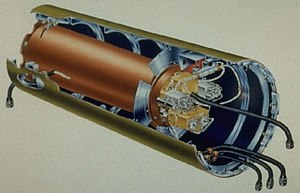The W85 was a thermonuclear warhead developed by the United States of America to arm the Pershing II missile. It was a variable yield device with a selectable yield of 0.3, 5, 10 or 80 kilotonnes of TNT (1, 21, 42 or 335 TJ).[2][3]
 A DOE drawing of the W85 warhead. | |
| Type | Nuclear weapon |
| Place of origin | United States |
| Production history | |
| Designer | Los Alamos National Laboratory |
| No. built | 215 |
| Specifications | |
| Mass | Less than 591 pounds (268 kg)[1] |
| Blast yield | 0.3, 5, 10 or 80 kt. |


Overview
editThe Pershing Ia missile was armed with a 400 kilotonnes of TNT (1,700 TJ) W50 warhead. By the early 1970s, it was clear that this was far too large to allow the missile to be used as a tactical nuclear weapon—at the time, 400 kilotons was larger than many strategic warheads. The Pershing II had a high-accuracy maneuverable reentry vehicle (MARV) equipped with a radar terminal guidance system, which allowed it to use the lower-yield W85 warhead. This warhead was derived from the B61 Mod 3 and utilized the same pit in the primary stage of the warhead,[4] but it has also been described as having a nuclear design similar to that of the B61-4.[5] The total weight of the Pershing II warhead section was 591 pounds (268 kg), which included the reentry vehicle.[6]
In 1987 a joint Army/Department of Energy study concluded that it was technically and financially feasible to replace the W50 warhead carried by Pershing 1a with the W85 warhead developed for Pershing II. However, with the signing of the Intermediate-Range Nuclear Forces Treaty, development on the conversion was terminated.[7]
After the Pershing missiles were scrapped, all of the W85 warheads produced were modified into B61 Mod 10 bombs.[8][9] 215 W85 warheads were manufactured.[10]
References
edit- ^ Pershing II Weapon System TM 9-1425-386-10-1 (PDF). United States Army. June 1986. p. 5-1. Archived from the original on 6 August 2020.
- ^ "The B61 Bomb". www.nuclearweaponarchive.org. Retrieved 2018-10-16.
- ^ "List of All U.S. Nuclear Weapons". www.nuclearweaponarchive.org. Retrieved 2018-10-16.
- ^ Jill C Fahrenholtz (September 1997). Development of an Automated Pit Packaging System for Pantex (PDF) (Report). Sandia National Labs. p. 15. doi:10.2172/534478. S2CID 107183716. SAND 97-2163. Archived from the original (PDF) on 2020-02-15. Retrieved 2021-02-09.
- ^ Sandia Weapon Review: Nuclear Weapon Characteristics Handbook (PDF) (Report). Sandia National Labs. September 1990. p. 79. SAND90-1238. Archived (PDF) from the original on 2022-01-12.
- ^ Pershing II Weapon System, p. 5-1.
- ^ Nuclear Weapons Surety - Annual Report to the President (PDF) (Report). US Department of Defense and US Department of Energy. 1987. p. 21. Archived (PDF) from the original on 26 July 2022. Retrieved 26 July 2022.
- ^ "The B61 Bomb". www.nuclearweaponarchive.org. Retrieved 2018-10-16.
- ^ Pike, John. "B61". www.globalsecurity.org. Archived from the original on 2010-04-17. Retrieved 2018-10-16.
- ^ Kristensen, Hans; Norris, Robert (27 November 2015). "The B61 family of nuclear bombs". Bulletin of the Atomic Scientists. 70 (3): 79–84. doi:10.1177/0096340214531546. S2CID 146744069.